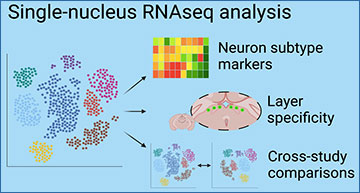The superior colliculus (SC) is a sensorimotor structure in the midbrain that integrates input from multiple sensory modalities to initiate motor commands. It undergoes well-characterized steps of circuit assembly during development, rendering the mouse SC a popular model to study establishment of neural connectivity. Researchers from the University of Miami Miller School of Medicine perform single-nucleus RNA-sequencing analysis of the mouse SC isolated at various developmental time points. Their study provides a transcriptomic landscape of the cell types that comprise the SC across murine development with particular emphasis on neuronal heterogeneity. The researchers report a repertoire of genes differentially expressed across the different postnatal ages, many of which are known to regulate axon guidance and synapse formation. Using these data, They find that Pax7 expression is restricted to a subset of GABAergic neurons. These data provide a valuable resource for interrogating the mechanisms of circuit development and identifying markers for manipulating specific SC neuronal populations and circuits.
Availability – A user-friendly web portal that allows for comparative gene expression analyses in these data across development: https://parklabmiami.shinyapps.io/superior-colliculus-snRNAseq/
Choi JS, Ayupe AC, Beckedorff F, Catanuto P, McCartan R, Levay K, Park KK. (2023) Single-nucleus RNA sequencing of developing superior colliculus identifies neuronal diversity and candidate mediators of circuit assembly. Cell Rep 42(9):113037. [article]





